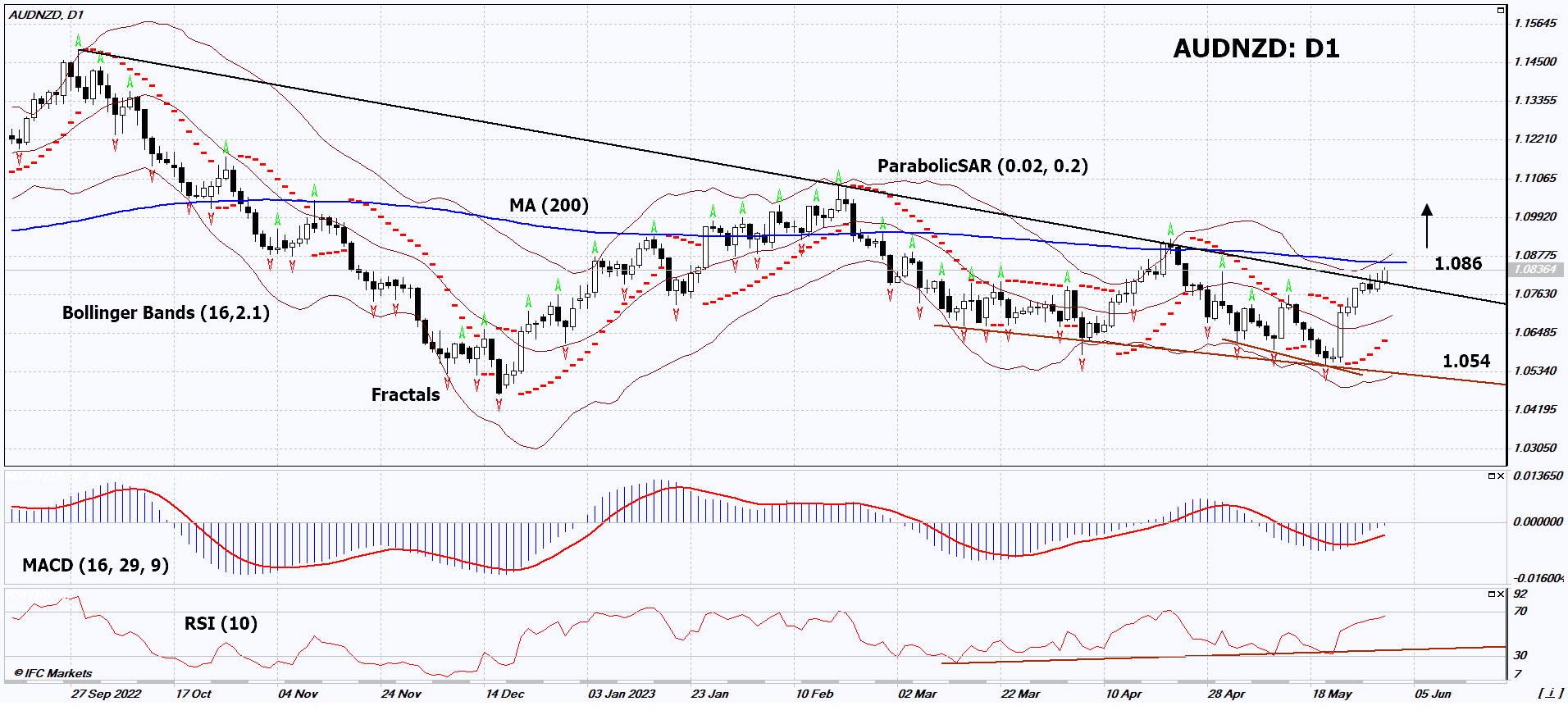- Analytics
- Technical Analysis
AUD/NZD Technical Analysis - AUD/NZD Trading: 2023-06-02
AUD/NZD Technical Analysis Summary
Above 1.086
Buy Stop
Below 1.054
Stop Loss
| Indicator | Signal |
| RSI | Neutral |
| MACD | Buy |
| MA(200) | Neutral |
| Fractals | Buy |
| Parabolic SAR | Buy |
| Bollinger Bands | Neutral |
AUD/NZD Chart Analysis
AUD/NZD Technical Analysis
On the daily timeframe, AUDNZD: D1 has broken out of a downtrend and approached the 200-day moving average line. It should break above it before opening a position. Several technical analysis indicators have formed signals for further upward movement. We do not exclude a bullish movement if AUDNZD: D1 rises above the last high and the 200-day moving average line at 1.086. This level can be used as an entry point. The initial risk limitation can be placed below the Parabolic signal, the last lower fractal, and the lower Bollinger Band line at 1.054. After opening a pending order, the stop should be adjusted following the Bollinger Bands and Parabolic signals to the next fractal low. Thus, we improve the potential profit/loss ratio in our favor. The most cautious traders can switch to the four-hour chart after executing the trade and set a trailing stop, adjusting it in the direction of the movement. If the price surpasses the stop level (1.054) without activating the order (1.086), it is recommended to cancel the order: internal changes are occurring in the market that were not taken into account.
Fundamental Analysis of Forex - AUD/NZD
Good economic data came out in Australia. Will AUDNZD quotes continue to rise?
The growth of Australia's Private New Capital Expenditure in the first quarter of 2023 turned out to be higher than expected, reaching +2.4% q/q. This is the highest level since the second quarter of 2021. The final Australia S&P Global Manufacturing PMI for May has been revised upward to 48.4 points compared to 48 points in April. The prices of Australian goods (RBA Index of Commodity Prices) decreased less than anticipated in May. The outcomes of the Reserve Bank of Australia (RBA) meeting on June 6th could be a significant factor influencing the dynamics of the Australian dollar. While no changes to the 3.85% interest rate are expected, market participants may react to statements made by representatives of the Australian central bank. Overall, the next week in Australia is expected to see the publication of many economic indicators, including GDP and the trade balance. In New Zealand, the Manufacturing Sales figure will be released on June 7th, and the Reserve Bank of New Zealand meeting will not take place until July 12th.
Explore our
Trading Conditions
- Spreads from 0.0 pip
- 30,000+ Trading Instruments
- Stop Out Level - Only 10%
Ready to Trade?
Open Account Note:
This overview has an informative and tutorial character and is published for free. All the data, included in the overview, are received from public sources, recognized as more or less reliable. Moreover, there is no guarantee that the indicated information is full and precise. Overviews are not updated. The whole information in each overview, including opinion, indicators, charts and anything else, is provided only for familiarization purposes and is not financial advice or а recommendation. The whole text and its any part, as well as the charts cannot be considered as an offer to make a deal with any asset. IFC Markets and its employees under any circumstances are not liable for any action taken by someone else during or after reading the overview.

